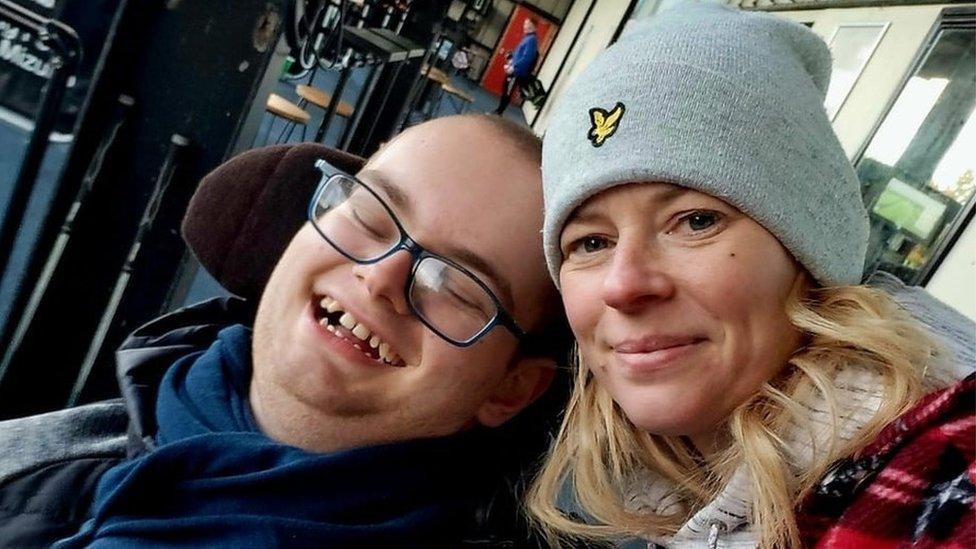Spinal injuries: Paralysed motorcyclist learns to walk again
- Published
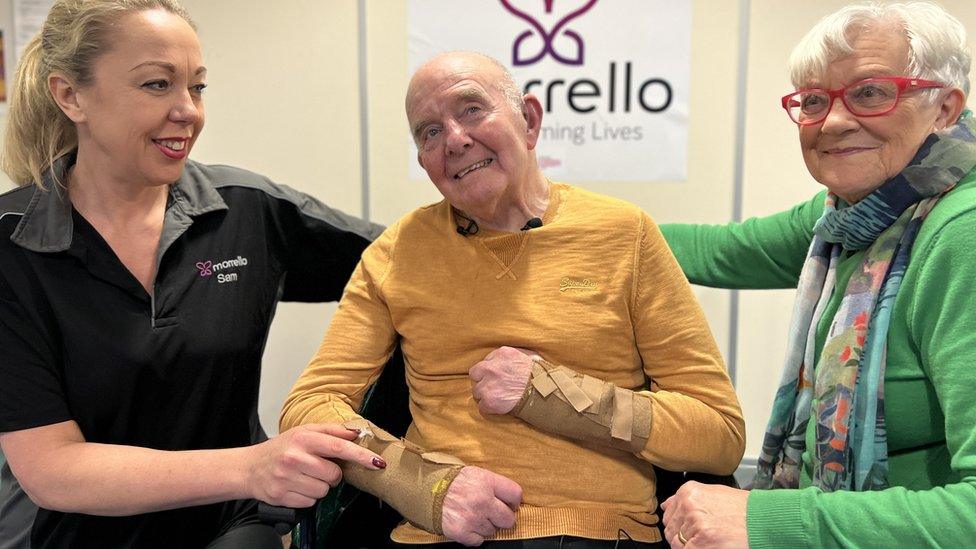
Harold, his wife Sybil, and clinical specialist Sam Miggins who he calls "a life saver"
A motorcyclist paralysed in a crash and told he would never walk again has taken his first steps with robotic legs originally developed for US soldiers.
But Harold Price, 79, is paying £800 a month to be treated privately after being denied help on the NHS.
His story is "very common" because physiotherapy services have been "left behind", a rehabilitation expert has said.
A health board said patients were free to choose non-NHS therapies.
It was on 11 June 2021 that Harold's life changed forever when he broke his neck in a crash 12 miles (19km) from his home in Griffithstown, Torfaen.
Recalling the fateful day, the retired fitter said: "I was going to go cycling and my [motorcycling] mate rang me up.
"But for five minutes and this wouldn't have happened."
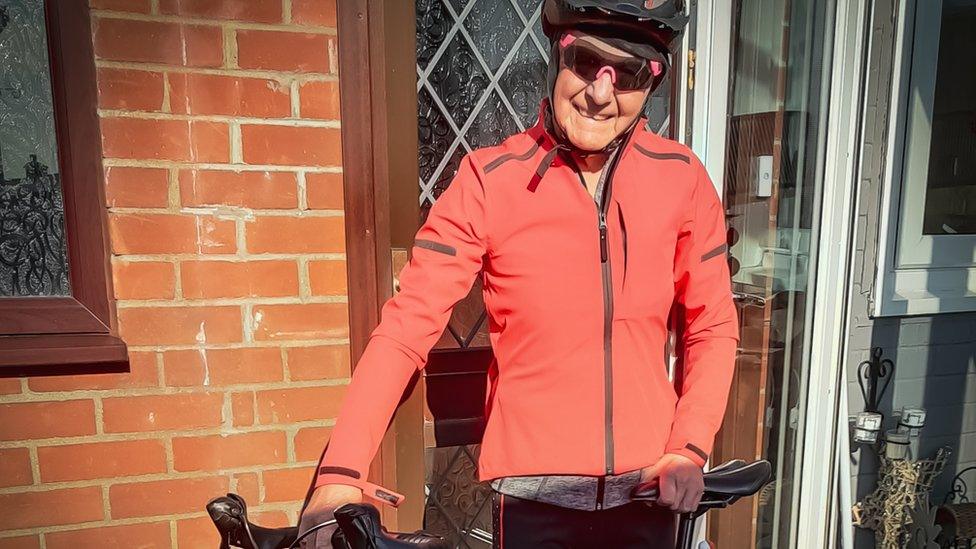
Harold was a keen cyclist, riding 90 miles (145km) a week
After bumping into the back of his friend's bike at about 15mph (24km/h), Harold came off his 500cc Honda Rebel, and was rushed to Cardiff's University Hospital of Wales.
Despite undergoing emergency spinal surgery, his hands and legs were left paralysed.
"They thought I wouldn't walk again," he said.
"I was really devastated. I thought 'I have got to get on my feet'."
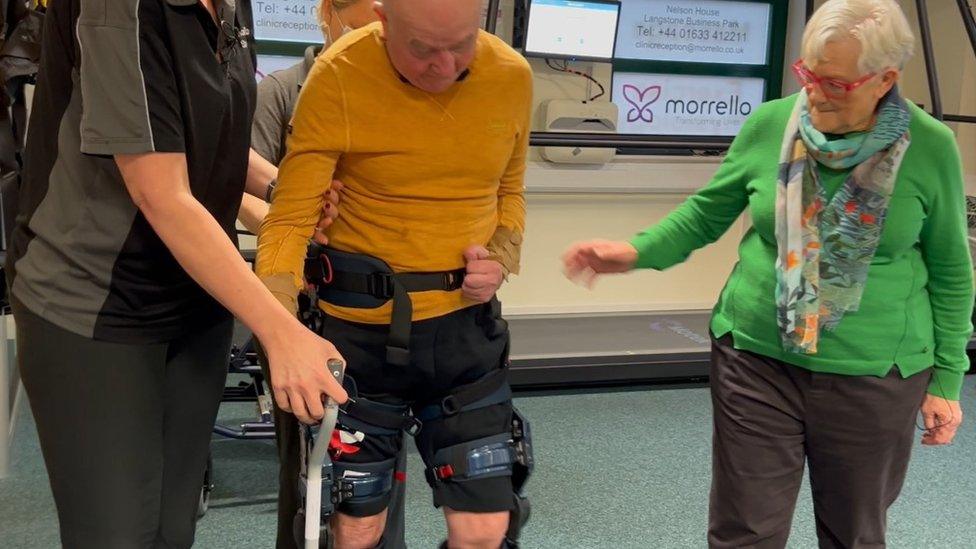
Harold taking his first steps since his accident with the help of wearable robotic legs, a treatment being trialled at a private clinic in Newport
Rehabilitation from a spinal injury often involves many hours of physiotherapy.
But Harold's clinical status - not able to walk again - disqualified him for physiotherapy on the NHS.
So he sat at home trying to teach himself to walk using a homemade device.
It led to a couple of falls and a lot of worry for Harold's wife.

Before starting physiotherapy at a private clinic, Harold tried to walk again with help from a friend, but had a couple of falls
"I turned my back and he was on the floor," remembered Sybil, 77.
"There didn't seem to be much hope.
"But having lived with Harold for 50-odd years, I knew he wasn't going to give up and he kept saying in the meetings, 'I'm going to walk'."
Sybil remembered being "very frustrated" because Harold was making progress even without physiotherapy, but his local GP was sticking with the original prognosis.
"They sent me a letter saying 'we can't do anything', they said 'he's not going to walk'," she said.
"There was nowhere to go, so we had to decide then we're either going to listen to them and Hal will sit in a wheelchair, or we are going to pay ourselves."
She found a private clinic specialising in spinal injury rehabilitation in Langstone, Newport.
"When they said on the national health he couldn't have any more physio, I found this place," Sybil said from the Morrello Clinic where Harold does an hour-long session twice a week.
"We really haven't looked back since."
Harold recently took his first steps since the accident using a walking frame with clinical specialist Sam Miggins crawling along the floor beside him "placing" his feet.
He called Ms Miggins his "life saver".
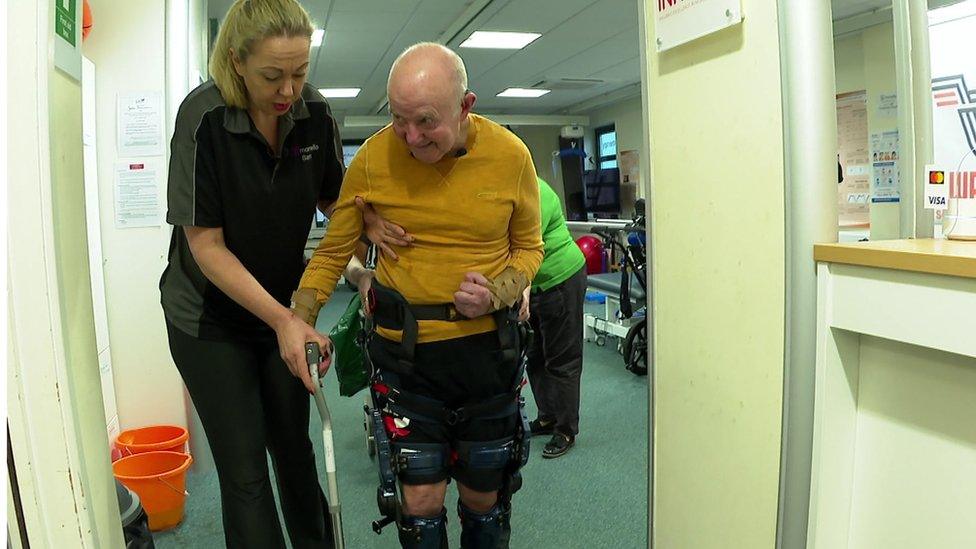
Robotic legs allow Harold to walk with a cane as he gets private treatment with clinical specialist Sam Miggins
The progress has come after Harold's determination during sessions at the Morrello Clinic meant he was selected for a trial with wearable robotic legs.
Keeogo, external was developed by Canadian company to increase the strength and endurance of US soldiers.
"The technology can help to pick up your feet," said Morrello's clinical director Jakko Brouwers, explaining how sensors in the robotic legs respond to the patient's movements.
It means Harold can walk from one end of the clinic to the other, getting the repetitions needed to learn to walk again.
"If you can only get fifty steps in a day that's fifty opportunities to learn," Mr Brouwers explained.
"With wearable robotics we can increase the amount of repetition."
Sessions with the robotic legs have also helped his mental health, making him think he has got "a bit of a chance" to walk again.
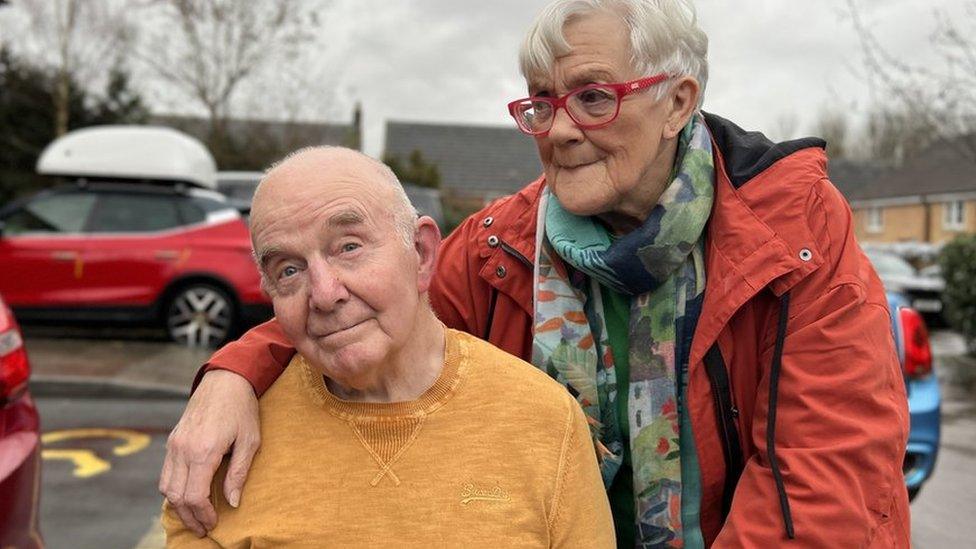
Harold has been determined to walk again ever since his accident
But it comes at a financial cost.
Harold pools his £350 monthly disability allowance from the Department for Work and Pensions with £450 of his own money to pay for eight hours of physiotherapy a month.
"We're not rich, but we can afford to prioritise the money that we've got for Harold," said Sybil.
Mr Brouwers said the NHS has to prioritise acute services over rehabilitation, adding: "There isn't really the emphasis on buying technology to enhance the rehabilitation experience that people are getting."
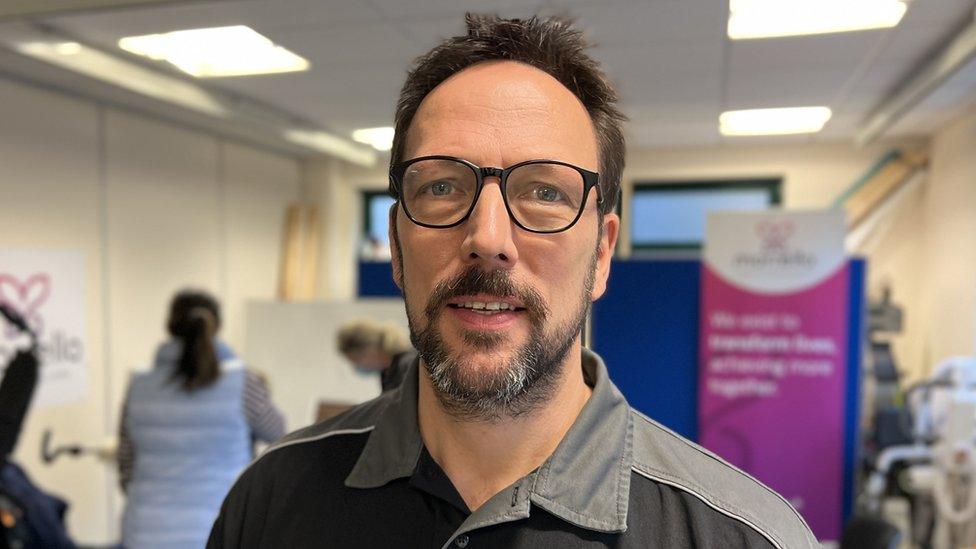
Mr Brouwers said Harold could be further along in his rehabilitation if there had been access on the NHS
"People should not be paying so much for access to equipment," he added.
Mr Brouwers sees a "common thread" of people who deteriorate physically and mentally when they are sent home from hospital.
"It is very important to keep the positive mindset after catastrophic injury and the outlook is bleak," he said.
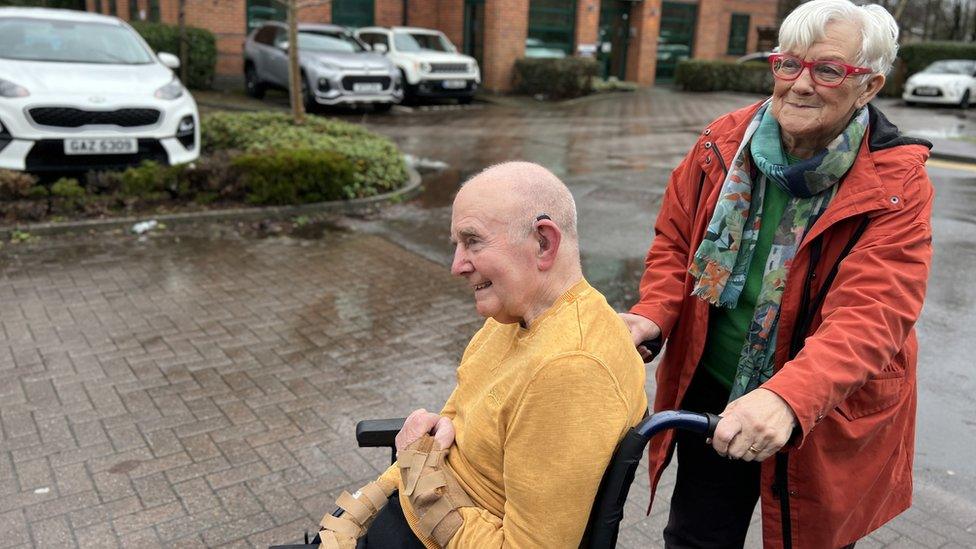
Harold is shy about going out in public in a wheelchair, with wife Sybil saying he sometimes struggles to accept he has a disability
Professor Diane Playford, a consultant in neurology and in rehabilitation medicine at University of Warwick, said it is "very common" to find patients in Harold's situation.
"Unfortunately, although the acute services have been developed, the rehabilitation services haven't and they've been left behind," she said.
But better rehabilitation would ultimately mean less pressure on acute services, Prof Playford added.
A spokesperson for Cardiff and Vale University Health Board said: "Most patients who are admitted to our specialist spinal rehabilitation centre at University Hospital Llandough are in the first phase of their rehabilitation journey.
"All outcomes and prognosis are made following individualised specialist multi-disciplinary assessments and patient outcomes vary, depending on level and complexity of spinal injury.
"We do not place a time scale on progress or limits on rehabilitation.
"On discharge, rehabilitation continues within the community and local health boards and professionals undertake further assessments regarding the therapy input required to support ongoing rehabilitation.
"All patients have the right to decide what is the best action for them, and this may be through non-NHS services."
A Welsh government spokesperson said: "We recognise the importance rehabilitation can have on a person's recovery which is why we are providing health boards with an additional £1.4m per year for community-based multi professional rehabilitation support workers, as well as £5m annually to fund more allied health professionals, which include physiotherapists, to provide rehabilitation services and support people to recover."
- Published1 January 2023
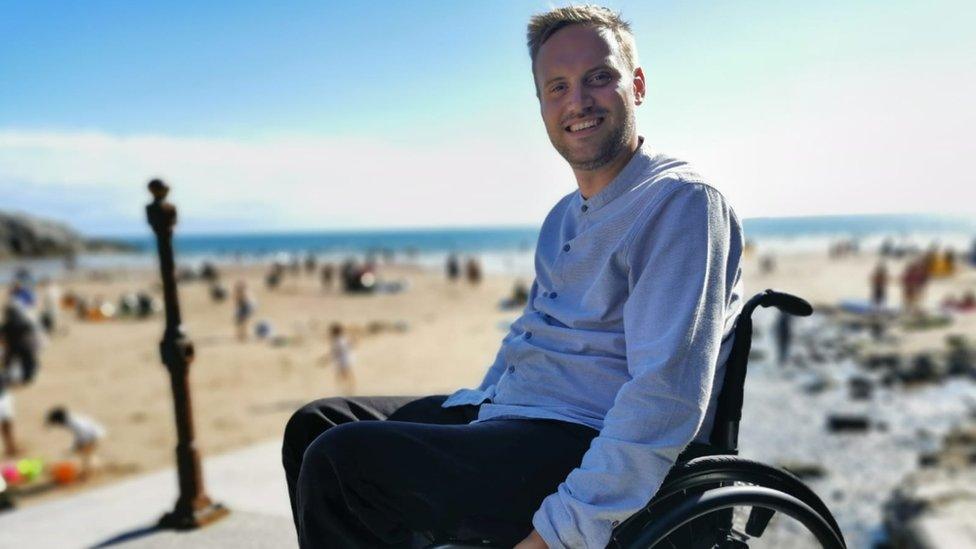
- Published16 January 2023
